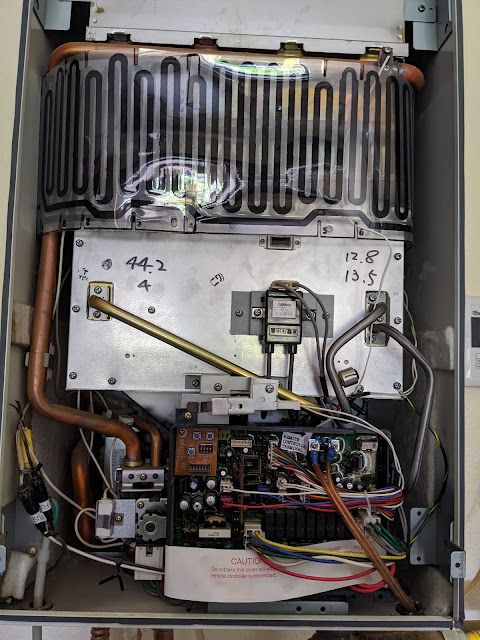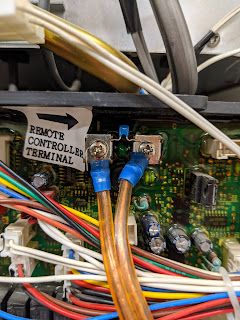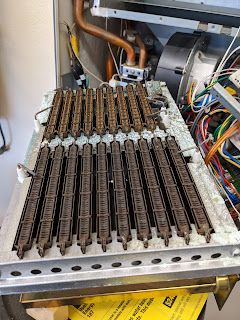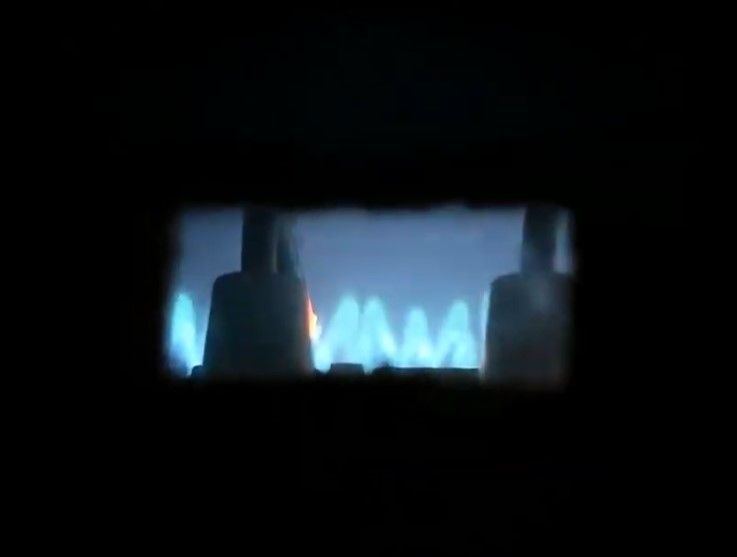Rheem Pronto Tankless Water Heater Repair
COVID appliance failure #2! The culprit was our Rheem Tankless Water Heater and took a fair amount of spelunking through the web, service documents, and a good old fashioned teardown to resolve the issues - plural as there were actually two error codes generated.

Error Code "76" #
The first error code indicated communication failure between the "Remote" (HMI device which attaches to the wall next to the water heater) and "PCB" (as there is only one printed circuit board in the unit, Rheem refers to it as "PCB").
Upon examination of the PCB, I noted a few of the capacitors had bulged. Typically one would desolder and replace with comparably rated parts, but with 1/2" of potting compound encasing the board, it would be quite the operation to selectively remove and re-pot.
I came across a random post on Amazon which mentioned resolving the issue by shorting the communication terminals with a capacitor - this implies that degradation of the capacitor(s) allows noise to propagate on the communication lines, shorting with a capacitor is a common technique to filter noise. I pulled out an assortment of ceramic capacitors I had on-hand and started with 4.7 nF, working my way to 220 nF at which point communication was reliable though a new error code appeared...

Error Code "C7 13" #
With the communication issue resolved the remote indicated a new error "C7 13" - insufficient oxygen in the combustion chamber.
At this point I performed a full teardown of the heart of the system to understand the theory of operation and search for obvious issues.
Corrosion Buildup #
The most obvious issue was the accumulation of blue-white powdery debris within the combustion chamber, heat exchanger, and exhaust. Buildup of debris in the exhaust or air intake systems could prevent sufficient air (oxygen) in the combustion chamber. Having dealt with my fair share of corroded batteries and acid cleaning of assorted copper parts, my first thought was copper corrosion due to the blue hues in the powder. With the amount of copper tubing above the combustion chamber, this was a fair assumption. The minute deposits from propane combustion are quite corrosive and it's likely that over time leads to some corrosion of the copper. A thorough cleaning with the shop vac took care of the mess.

"Oxygen Sensor" #
The water heater uses a simple method for sensing oxygen - when in operation, an orifice expels a calibrated amount of gas within a chamber, at the end of this chamber sits a thermocouple which measures the temperature of the flame generated. If there is insufficient oxygen, the flame will burn at a lower temp and thus trigger a system shutoff.
As I had everything apart, I dealt with the low hanging fruit - Combustion product buildup preventing proper sensing of temperature - gentle cleaning of the thermocouple probe with 1,000 grit sandpaper Combustion product buildup on the gas orifice preventing proper flow - gentle cleaning of the orifice with 1,000 grit standpaper It's important that a high grit sandpaper is used as damage to the thermocouple or orifice will throw off the somewhat fine balance of the system.
Success #
With the various fixes in place, I carefully reassembled the unit and commenced a quick combustion check followed by a 10 minute hot water test - success!

- Previous: Hardwood Propagation of Hybrid Willows
- Next: Automatic Chicken Coop V4